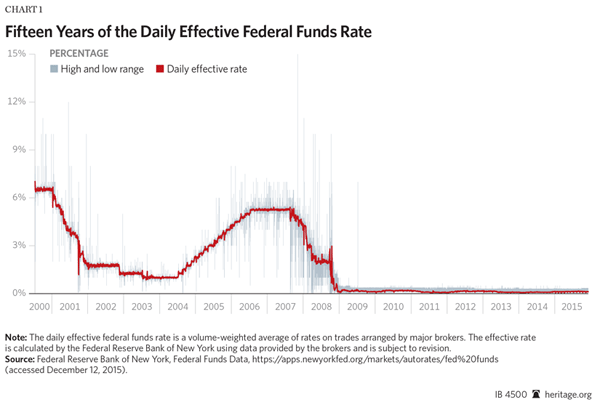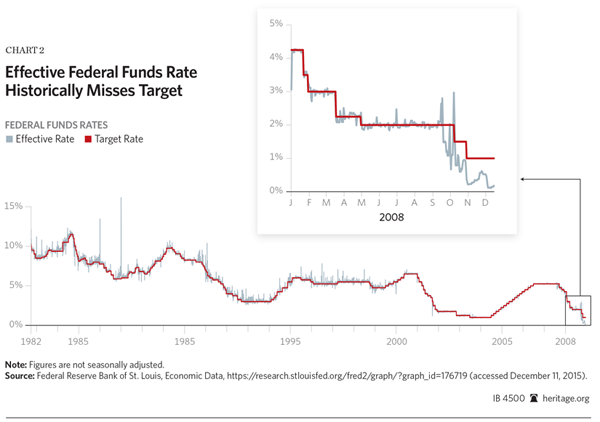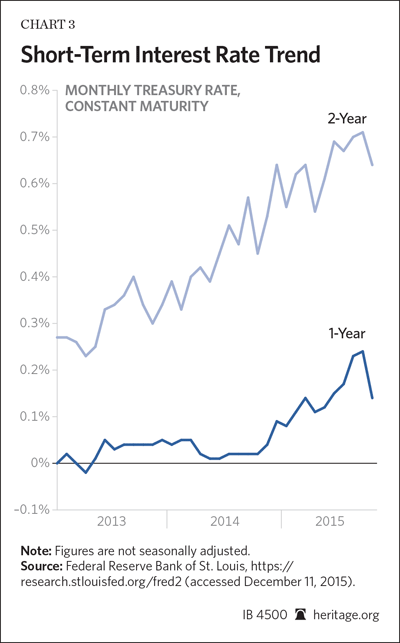The Federal Reserve (Fed) has not changed its federal funds target rate since 2008. Such a policy is unsustainable in the face of market forces that change interest rates. This statement may seem surprising given the widespread belief that the Fed sets interest rates, but, in fact, the Fed does not set interest rates.
As a matter of fact, the Fed does not set even the federal funds rate, the interest rate banks charge each other to borrow reserves. It merely sets a target and tries to push the average of federal funds rates toward that target. The Fed certainly has influence over market interest rates, but the Fed cannot make interest rates—even the federal funds rate—whatever it wants them to be. The misplaced focus on the Fed’s supposed responsibility for low interest rates obscures the debate over major policy reforms that could improve the nation’s monetary system.
The Federal Funds Rate Target
The Federal Reserve sets a target for the federal funds rate, but it does not set the federal funds rate itself. Furthermore, what is commonly called the federal funds rate is actually an average measure called the effective federal funds rate. The Fed targets this average[1] because there is no single federal funds rate in this market. Instead, banks regularly conduct overnight loans of reserves on an as-needed basis and negotiate their own rates. There is actually a great deal of dispersion around the effective fed funds rate each day. (See Chart 1.) The Fed sets a target consistent with its policy goals, and then tries to push the effective fed funds rate toward that target by changing the quantity of reserves in the system via open market operations.[2]
Does the Fed Hit Its Target?
The long-term data shows the effective fed funds rate does not always match the Fed’s target. (See Chart 2.) More importantly, the recent financial crisis highlights how powerless the Fed can be when faced with major changes in market interest rates. The Fed clearly followed rates downward after September 2007, when it began lowering its target from 5.25 percent to 1 percent in little more than one year.
The Fed then ditched the idea of a single target in favor of a target range (from zero percent to 0.25 percent), while nearly abandoning interest rate targeting altogether. In 2008, Fed chairman Ben Bernanke noted: “With respect to monetary policy, we are at this point moving away from the standard interest rate targeting approach and, of necessity, moving toward new approaches.”[3] If the Fed did have tight control over interest rates, it would have prevented them from falling in a manner that jeopardized its core approach to monetary policy. Instead, the rapid decrease in rates left the Fed searching for new ways to conduct policy.
Interest Rate Targeting: The Conventional Story
Since the 1980s, the Fed has conducted monetary policy by targeting the effective federal funds rate through open market operations. The Fed conducts these operations—buying and selling securities—to influence the federal funds rate, which, in turn, is said to affect other interest rates. Ultimately, these interest rate changes are said to shape other economic factors such as consumer spending, business investment, and employment. In other words, the Fed tries to trigger a chain of events by altering the federal funds rate.
One problem with this story is the evidence suggesting that the Fed is more likely to change its target in response to interest rate changes rather than to cause rates to change via its targeting procedure.[4] Recent trends in some interest rates support this finding, and also suggest the Fed will soon raise its target. (See Chart 3.) Another problem for this conventional story is that there is little evidence to support that interest rate changes affect aggregate spending in the economy. In a widely cited 1995 research paper, Ben Bernanke pointed out this apparent puzzle and argued that monetary policy effectiveness depended (partly) on the Fed’s ability to influence bank lending.[5]
What Does the Fed Control?
The Fed has direct control over a small number of policy instruments, such as the rate it charges banks to borrow at the discount window, the interest rate it pays on reserves, and the monetary base. The monetary base consists of all U.S. currency in circulation plus banks’ reserves, and its level determines the maximum quantity of money that can be created in the banking system. Provided banks have sufficient reserves, banks can then make loans and create new deposits, thus adding to the broader monetary supply. The Fed has control over the base because only the Fed can change the total amount of reserves in the banking system.[6]
The Fed’s open market purchases increase the base and aim to increase bank lending (and with it, economic activity), while its open market sales would have the opposite effect. Naturally, the total quantity of reserves in the banking system should have some relation to the federal funds rate, so it makes sense that the Fed would target this rate to achieve its policy objectives. It does not follow from this relationship, however, that the Fed’s open market operations exhibit precise control over the fed funds rate, the broader monetary supply, other market interest rates, or even aggregate economic activity.
What Can Monetary Policy Do?
Even without precise control over the federal funds rate (or other rates), the Fed’s policy actions can affect the economy regardless of whether interest rates are historically high or low.[8] For instance, the Fed’s policies can lead to excessive lending, relative to the level supported by underlying economic conditions, even though interest rates are historically high. Conversely, the Fed can exacerbate or cause a contraction in lending regardless of the level of interest rates, thus worsening or causing a recession. It appears the Fed made such a mistake in August 2008, when it decided against loosening its monetary policy stance.[9]
The Fed made this decision even though nominal gross domestic product has been on a downward trend since 2006, and then bank lending sharply declined.[10] It appears the Fed made this error because it placed too much importance on its interest rate target and on inflation. In particular, Bernanke claims that the Fed decided against expansionary monetary policy so that the Fed could keep “short-term interest rates where we wanted them,” and because the Fed forecasted inflation would come in at “an uncomfortable 3.5 percent in the second half of the year.”[11]
While the Fed’s concern with inflation is understandable, given that the central bank is directly responsible for the price level, this policy objective has always been controversial.[12] In the post–World War II era, central banks in most developed countries have tried to stabilize the price level by focusing on inflation rather than the price level itself. The Fed now defines price stability as 2 percent annual inflation, but this interpretation of price stability can be problematic for several reasons. For instance, while the average rate of inflation in most developed countries has declined, particularly since the 1980s, the price level itself has been widely divergent across countries.[13]
Separately, creating a constantly rising price level—even at a “low” rate—runs directly counter to the fact that a falling price level can be the by-product of a healthy, growing economy. For example, as business owners take advantage of new technology (productivity increases), the price level should fall, thus enabling consumers to buy more goods at lower prices. Using monetary policy to produce constant inflation, of course, prevents consumers from enjoying these benefits.[14]
Conclusion
The level of interest rates has become a distraction from much-needed monetary policy reforms even though the Fed does not have precise control over interest rates. The Fed’s policies can have a major effect on the economy regardless of whether interest rates are high or low by historical standards. To minimize harmful effects from the Fed’s actions, Congress should end discretionary monetary policy and direct the Fed to implement rules-based policies that move the U.S. toward a truly competitive monetary system.
—Norbert J. Michel, PhD, is a Research Fellow in Financial Regulations in the Thomas A. Roe Institute for Economic Policy Studies, of the Institute for Economic Freedom and Opportunity, at The Heritage Foundation.

